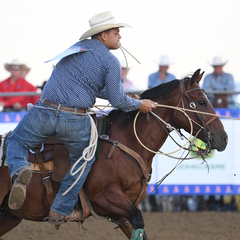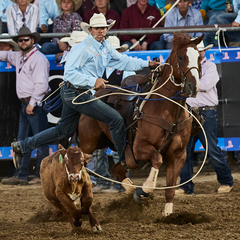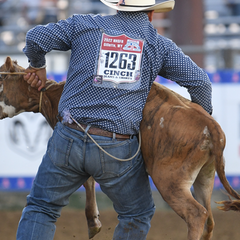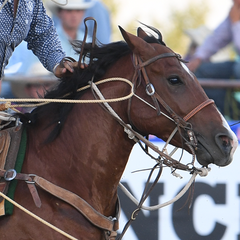
Tie-Down Roping Techniques
Calf roping, also known as tie-down roping, is a classic rodeo event that combines speed and precision with practical skills that are used daily on the ranch. It’s a sport that has evolved over the years because of cowboys like Roy Cooper, Joe Beaver, Fred Whitfield, and Cody Ohl, pushing the envelope with new techniques and roping faster than anyone ever before. This article delves into some basic fundamentals of calf roping, offers insights into techniques that can help elevate your performance in the arena, and helps point out some specialized equipment you'll need to rope calves.
Understanding Calf Roping
Calf roping is more than just a timed event, it’s a showcase of horsemanship, calf handling, athleticism, and roping ability. In this event, a cowboy must start behind what is called a barrier, give the calf the proper head start or be penalized, chase the calf, rope it, and then dismount to tie three of the calf’s legs together, all in the shortest time possible. Precision, timing, and technique are crucial.

Essential Techniques in Calf Roping
-
Horse Positioning and Control: A successful run starts with your horse; how well they score, start off your hand, run, and rate when getting to the calf. This takes a lot of time in the saddle, making sure your horse neck reins when needed, rates when approaching the calf, and responds to any cues that may be given by the roper. Typically, this requires more time just riding your horse than it does actually roping on them. All of this allows the roper to get into position to take a high-percentage throw to catch the calf.

-
Rope Handling and Throwing: Handling your rope is a skill that requires practice. The more time you spend with a rope in your hand, roping the dummy, swinging it, and doing rope tricks, the better understanding you will have of how your rope works and feels in your hand. When swinging your loop, it’s essential to keep a little bit of tension on the rope between your hands and swing it with a smooth rhythm, keeping your swing speed leveled off. The tension allows you to measure off how much rope you need to throw when you release your loop. When throwing your loop, work on precision over power. Follow through with your pinky finger down and your hand to your target, which is usually where the calf’s neck ties into its shoulder. Your loop size will be a matter of preference. When starting out, using a larger loop will help you feel where your tip is in your swing and allow you to catch more calves. As you progress, you can adjust your loop size to fit your style and preference.

-
Quick and Safe Dismount: Once the calf is roped, it is most important to get your slack out of your loop and stop your horse. This will help decrease the chances of your horse stepping over the rope because your horse will be stopped with the calf still moving forward. As your skills progress, you will be able to work on stepping off with your slack and handling your slack to place the calf to the inside or outside and keep them standing on the end of the rope.

-
Approaching and Flanking the Calf: You’ll want to run straight down the rope, with your left hand on the rope and place your knee in the crease of the calf’s neck and shoulder to “block off” the calf as you lower your butt and step your right foot around, staying tight to the calf and bending your knees to get slightly under the calf. From here, you will flank the calf by lifting the rope around the calf’s neck with your left hand, using your legs in a power-clean type motion, while your right hand pulls the calf’s right flank up in a rolling motion over your right knee.

-
Tying Techniques: The tie is what secures your time in the competition. The most common method is the “two wraps and a hooey.” This involves wrapping your piggin’ string around three the calf’s legs twice before securing it with a half hitch knot (hooey)around the top two legs. There must be at least one full wrap around three legs, and the legs must stay crossed throughout the tie inspection period of 6 seconds. Although it is a timed event, this is where the saying “slow down to be fast” really comes into play, ensuring a smooth tie and not getting in a speed jam will pay huge dividends, and the more you practice, the faster you will get.

Advanced Strategies
- Reading the Calf: Just like team ropers study steers, calf ropers must study calves. Knowing how your calf will break from the chute (start), how they run in the arena, and if they kick allows you to make a base game plan when competing. Keep in mind, the fresher the calves are, the less likely they are to have a pattern. The more they’ve been roped, the more honest they will be. You can also manipulate a calf’s pattern by your horse position.
- Rope Maintenance: Rope maintenance is especially important when talking about calf ropes. It is best to keep them in a can and learn how heat and humidity affect how your ropes feel. Once you’ve determined a feel you like, you can add humidity by keeping wet rags in the center of your rope can if needed. You should also be keeping it in a constant temp by either keeping it in the truck or trailer, or you can use a Regulator Pro, and keep rope powder on your ropes to keep them feeding smooth.
- Mental Preparation: Calf roping, just like any other sport, requires more mental training than physical. Stay disciplined in the practice pen to perform each step correctly, and develop a routine that helps you focus and stay calm under pressure at the rodeos and jackpots.
Training and Practice
- Horsemanship: This is the MOST IMPORTANT piece to any timed event, especially calf roping. Spend time riding your horse. Horsemanship techniques can be taught, but you cannot execute a technique until you’ve developed a feel for a horse. You need to be able to effectively communicate with and control your horse without a rope and a calf before you can expect to successfully complete a run. It may even be beneficial for new ropers to back in the box, nod, score, chase the calf, get to a position, maintain that position for a few strides, and then stop their horse, doing this multiple times so they can develop a feel for each step before incorporating a rope.
-
Roping Dummies: If you’re just starting out, practicing on a ground roping dummy is important to help you develop a feel for your rope and learn to handle your slack. This helps in developing a solid foundation of the correct muscle memory without the unpredictability of a live animal.
From the ground, you can practice on one of the roping sleds. This allows you to focus on riding to the correct position each time, allowing you to rope and set up your horse to give yourself a good go every time. - Live Calf Practice: When practicing on live cattle, focus on technique over speed. New ropers should start on slower cattle. This allows them the time to execute each step and not rush, which can cause accidents. As skills progress, the speed of the cattle can increase, but you have to do more correctly on slow cattle than you do when roping fast cattle. Speed will come with time and muscle memory.
Safety First
Tie-down roping/calf roping, like any rodeo event, carries risks. There are a couple of things you can do to help minimize the risk involved. The use of a neck rope and a rope keeper on your headgear is imperative to help keep your horse facing the correct direction and helps prevent getting tangled in the rope. Always have someone there with you when you practice. They can run the chute and then untie for you after the run. Both of you should be packing knives in case a rope needs to be cut. Finally, you can protect your horse by using quality overreach and sports medicine boots.

Conclusion
Calf roping is a challenging but rewarding sport that requires a lot of commitment to practice and execution. It is important to find a solid coach/mentor, and by focusing on the proper execution of each step, you can refine your skills and improve your performance. Consistent correct practice, patience, and respect for the sport and its animals are key to success in the arena. Always remember that you’re never too good to learn something new, and there are a ton of resources available like roping.com that offer in-depth instruction to help you continue to improve in your horsemanship and roping.

